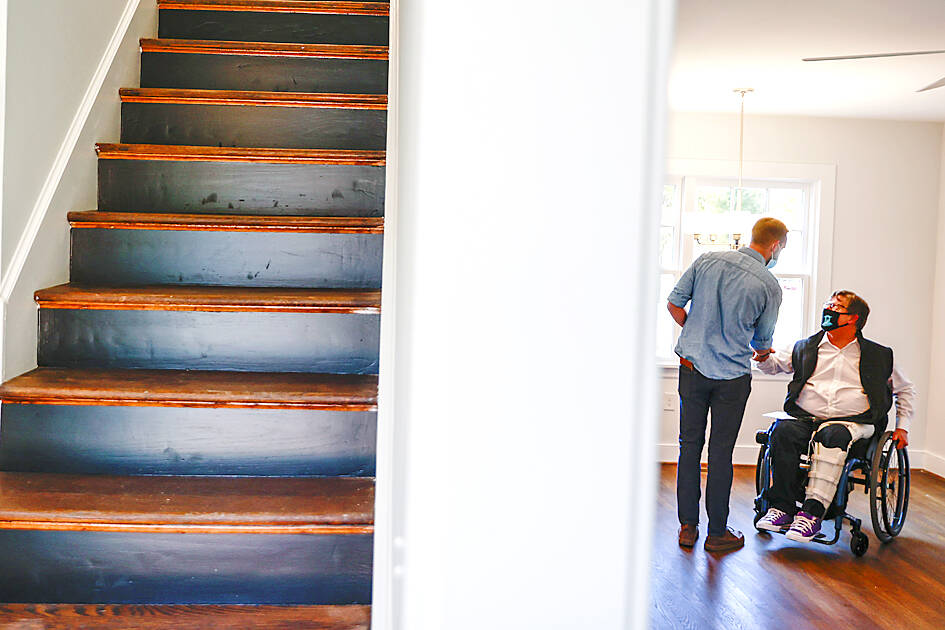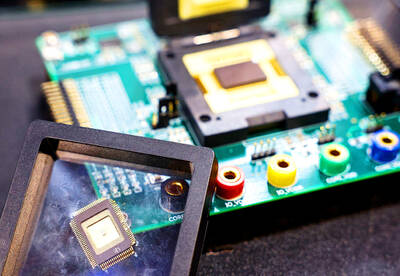Inna and Vladimir Giterman tinkered with several business ideas before finding their niche — and their version of the “American dream” — with crepes.
Both immigrants, and both deaf, the Gitermans started Crepe Crazy in 2007. What began as a mom-and-pop shop at festivals has grown into a full-blown family business with multiple food trucks, two brick-and-mortar restaurants in Texas and a franchise in Baltimore, Maryland.
Everyone who works for the company, including the Gitermans’ two adult children, are either deaf or “deeply involved with the deaf community,” Inna Giterman said in an e-mail.

Photo: AP
Staff communicate using American Sign Language. Customers who cannot sign still order with their hands — by pointing.
Crepe Crazy is one of about 1.8 million businesses in the US that is owned by someone with a disability, according to the American Community Survey conducted by the US Census Bureau (although experts believe that number to be conservative).
While the path to entrepreneurship is rarely easy, business owners with disabilities often need to overcome additional challenges, such as societal misconceptions, barriers to financing, extra living costs and lack of accommodations, among other things.
Entrepreneurs often have to leverage personal savings, credit cards or even a personal loan to fund their business at the outset, but that is complicated for founders with disabilities, especially if they rely on Supplemental Security Income (SSI) and Medicaid, which have income and asset limits, said Nikki Powis, director of small-business programs at the National Disability Institute (NDI).
“A person receiving SSI is only allowed to have US$2,000 in assets,” Powis said. “That makes it very difficult to save money to start a business — and do it yourself — because you can’t have more than US$2,000 in your bank account.”
There are workarounds, including leveraging Achieving a Better Life Experience accounts, tax-free savings and investment accounts that do not count toward the account owner’s asset total.
Business owners should also tap the expertise of a professional to help with benefits planning, Powis said, adding that the NDI can help connect people with those experts.
“Yes, there are barriers and challenges, but you need to find people who are experts that can help you navigate that,” Powis said. “And it should never stop somebody from moving forward with their dreams.”
Securing funding through business loans or venture backing often requires a higher bar for entrepreneurs with disabilities, too. In part because banks, loan officers and investors frequently underestimate what people with a disability are capable of accomplishing.
That stigma can color nearly every business interaction, from winning contracts and customers to leasing commercial real estate.
“I would say probably 99.5 percent of the people that I’ve talked to said they’ve experienced that at some level or other,” Powis said, citing several examples.
These include one business owner who has lost contracts after the other party realized he had a disability, and a female founder who was told by an investor: “Come back to me when you have a male counterpart without a disability.”
Community development financial institutions such as DreamSpring and the Disability Opportunity Fund are working to get business loans to more entrepreneurs with disabilities. Organizations such as 2Gether-International, a start-up incubator for disabled founders, and Communication Service for the Deaf’s Social Venture Fund also offer opportunities for funding, coaching and community with peers.
Diego Mariscal said he sees disability as a strength rather than a weakness for entrepreneurs, which is why he started 2Gether-International to help rewrite the script surrounding people with disabilities.
“Oftentimes, you talk about disability as something that needs to be accommodated or fixed or cured,” said Mariscal, who has cerebral palsy.
In reality, people who live with a disability are resilient as a default — and that’s a “competitive advantage,” he said.
“As disabled people, we have to figure out how do you get dressed, how do you drive, how do you communicate. We have to figure out how to live in a world that is not built to fit our needs,” Mariscal said. “Those skills, those survival skills, can be translated into entrepreneurship skills.”
The Gitermans are changing the narrative, too, one customer at a time. While customers come to their food trucks and restaurants for tasty crepes, they also get a glimpse at a thriving business run almost entirely by deaf people. This leaves an impression.
“We appreciate that they come in for food because they know it’s uniquely good,” Inna Giterman said. However, “it is more satisfying knowing that they leave with more than just a happy stomach.”
This article was provided to The Associated Press by the personal finance Web site NerdWallet.

WEAKER ACTIVITY: The sharpest deterioration was seen in the electronics and optical components sector, with the production index falling 13.2 points to 44.5 Taiwan’s manufacturing sector last month contracted for a second consecutive month, with the purchasing managers’ index (PMI) slipping to 48, reflecting ongoing caution over trade uncertainties, the Chung-Hua Institution for Economic Research (CIER, 中華經濟研究院) said yesterday. The decline reflects growing caution among companies amid uncertainty surrounding US tariffs, semiconductor duties and automotive import levies, and it is also likely linked to fading front-loading activity, CIER president Lien Hsien-ming (連賢明) said. “Some clients have started shifting orders to Southeast Asian countries where tariff regimes are already clear,” Lien told a news conference. Firms across the supply chain are also lowering stock levels to mitigate

Six Taiwanese companies, including contract chipmaker Taiwan Semiconductor Manufacturing Co (TSMC, 台積電), made the 2025 Fortune Global 500 list of the world’s largest firms by revenue. In a report published by New York-based Fortune magazine on Tuesday, Hon Hai Precision Industry Co (鴻海精密), also known as Foxconn Technology Group (富士康科技集團), ranked highest among Taiwanese firms, placing 28th with revenue of US$213.69 billion. Up 60 spots from last year, TSMC rose to No. 126 with US$90.16 billion in revenue, followed by Quanta Computer Inc (廣達) at 348th, Pegatron Corp (和碩) at 461st, CPC Corp, Taiwan (台灣中油) at 494th and Wistron Corp (緯創) at

NEGOTIATIONS: Semiconductors play an outsized role in Taiwan’s industrial and economic development and are a major driver of the Taiwan-US trade imbalance With US President Donald Trump threatening to impose tariffs on semiconductors, Taiwan is expected to face a significant challenge, as information and communications technology (ICT) products account for more than 70 percent of its exports to the US, Chung-Hua Institution for Economic Research (CIER, 中華經濟研究院) president Lien Hsien-ming (連賢明) said on Friday. Compared with other countries, semiconductors play a disproportionately large role in Taiwan’s industrial and economic development, Lien said. As the sixth-largest contributor to the US trade deficit, Taiwan recorded a US$73.9 billion trade surplus with the US last year — up from US$47.8 billion in 2023 — driven by strong

ASE Technology Holding Co (ASE, 日月光投控), the world’s biggest chip assembly and testing service provider, yesterday said it would boost equipment capital expenditure by up to 16 percent for this year to cope with strong customer demand for artificial intelligence (AI) applications. Aside from AI, a growing demand for semiconductors used in the automotive and industrial sectors is to drive ASE’s capacity next year, the Kaohsiung-based company said. “We do see the disparity between AI and other general sectors, and that pretty much aligns the scenario in the first half of this year,” ASE chief operating officer Tien Wu (吳田玉) told an